Waveform Magazine Therevox Interview
July 18th, 2024 posted by mike under Therevox News.Waveform Magazine is probably my favourite magazine: legit interesting interviews and products from very creative synth people printed on actual physical paper! I met Ellison the editor of Waveform at Knobcon last year and we spent at least two hours in the hotel lobby talking about bicycles, nature, Vermont, probably politics, and even synthesizers. A few months later we reconnected over video chat for a proper interview that was published in Waveform Issue 13. Here is a PDF version of the interview portion, but check out the whole magazine if you get a chance!
Improving our Tweed Road Case
December 17th, 2021 posted by mike under Therevox News, Workshop Updates.To accommodate for the larger playing area in the ET-5, the outside dimensions had to change compared to the ET-4. This gave me the opportunity to rethink our Tweed Road Case and to ultimately design a better case for our synthesizers.
The Original Tweed Road Case
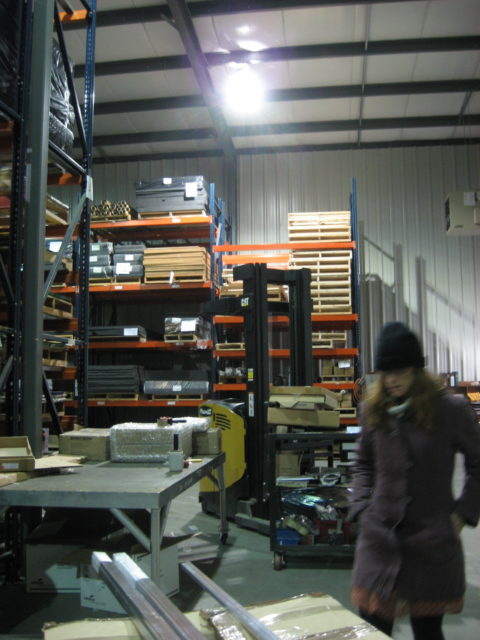
Melissa evaluating case hardware for the first case.
Designing our very first case and the ability to build it in-house was definitely an uphill battle. We wanted the perfect case. First we visited with a local flight case designer, whose heavy industrial cases are used by touring bands around the world. While the case certainly offered a lot of protection, they are extremely heavy with aggressive steel corners. We then met with case hardware manufacturers Penn-Elcom, whose headquarters is not to far from our shop. Their aluminum extrusion system looked ideal for the “every day case” that we had in mind. At the time, Melissa was doing a lot of textile work and we found ourselves in stores looking at various tweed fabrics. Once we figured out how to laminate that tweed onto the plywood sides of our new cases, the Therevox Tweed Road Case was born.
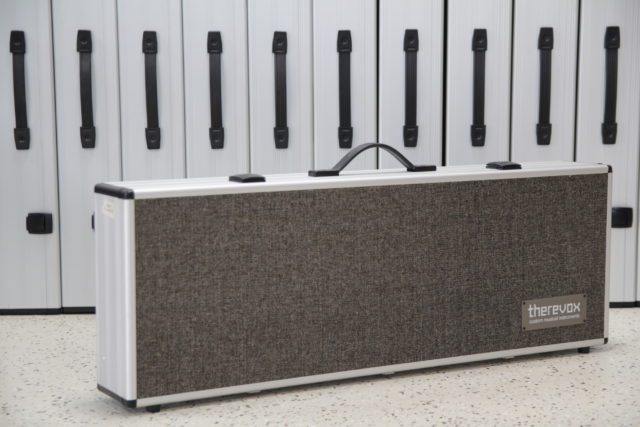
The final batch of Tweed Road Cases in the Therevox shop.
Approximately 50 cases were built from 2012-2018, with all of the inside foam cut with my Mom’s electric turkey knife. While I am proud of our first attempt at building a case, there were a few issues that I wanted to address now that I was given the opportunity of redesign. The case was heavy, despite using hollow aluminum. The aluminum extrusions often arrived scratched from Penn-Elcom, forcing us to return many pieces and wait for replacements. While the accessory area allowed for the power supply and expression pedal to be carried, this resulted in a heavy case that was not comfortable to carry for long periods of time. In fact, during a trip to Montreal I had to improvise and add wheels to the bottom of the case to easily move it down streets and through subway stations.
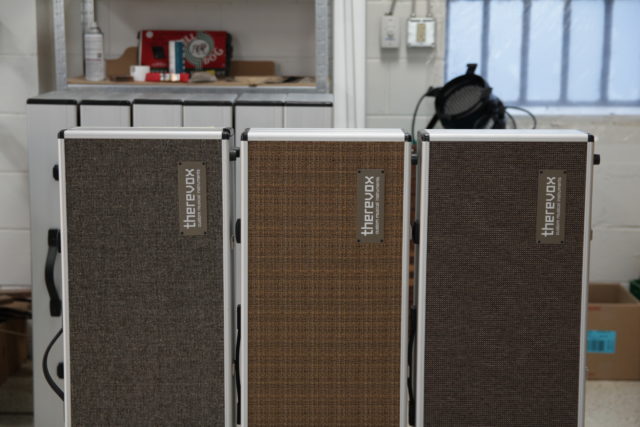
Our initial and subsequent tweed fabrics were discontinued, so the case was made in 3 variations from 2012-2018
The New Case Tweed Hard Case
For 25 years I have been carrying around my favourite guitar in a standard hard shell case and it has suited the job perfectly. I wanted the exact same style case but for the ET-5. We reached out to the Canadian manufacturer that made my guitar case and talked to them about building one for the ET-5. After we had our specs and drawings made up, we went to the task of finding a new tweed fabric that would match the new case styling. To make the case as small and light as possible, I decided to get rid of the accessory section of the case. It is still possible to fit the power supply and a few cables in the case on top of the ET-5 fingerboard, and the padded handle is a lot more comfortable than the old strap-stype handle.
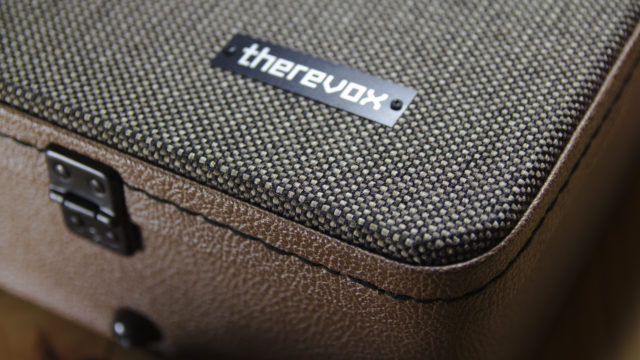
Anodized aluminum logo plate
We ordered hundreds of samples of fabric and tolex coverings and after going through them all, Melissa and I came to a very nice combination that I’m very happy with. The new case feels like a piece of vintage luggage and fits the ET-5 like a glove. While I am sad to see the old case go, this case is definitely an improvement.
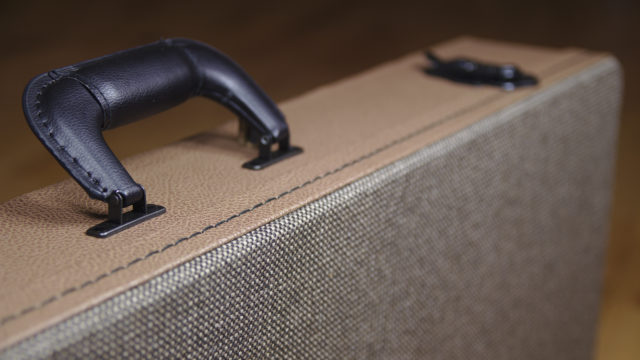
New padded handle and tweed fabric.
The new Tweed Hard Case is available now for $350 USD.
Ondes Martenot presentation at TSF 2019
January 17th, 2020 posted by mike under Therevox News.Toronto Sound Festival has been one of my favourite events after being asked to display the Therevox ET-4 there in 2018. Held once again in the Polish Combatants Hall, a very beautiful building in downtown Toronto, TSF 2019 did not disappoint with a great concert on Saturday night that involved tape loops stretching across the stage.
I gave a talk in the main hall called “Ondes Martenot and the Pursuit of Musical Expression” where I was able to share some of the insights and research that I have been doing into the life and creative genius of Maurice Martenot, the inventor of the Ondes Martenot.

Almost 100 years ago, Maurice was one of the first people in the world to combine knowledge of electronics and a love of music. After discovering that two radio frequency vacuum tube oscillators could be combined to make a controllable sound, Maurice spent the rest of his life working on the interface between the musician and this new form of sound creation. With feedback from musicians and composers, Maurice Martenot constantly tweaked and revised his electronic instruments to be expressive to physical nuances to continuously control pitch, amplitude and timbre. His vision of an electronic instrument eschewed any attempts at automation that we find common in electronic instruments today. His further inventions of the Metallique and Palme resonator were devices that used physical means to modify the sound of his instrument by adding further complexity and unpredictability that balance the rigid laws of electronics.
Maurice Martenot died in 1980, the same year that I was born. I was first introduced to the Ondes Martenot twenty years ago and I have been pursuing a parallel path ever since. My intention is not to remake what M. Martenot has done, but to preserve the spirit of his inventions as they apply to new sounds and possibilities. I think about him more than I think about any other ghost in my life and when you touch the ring and the intensity keys of the Therevox, you are directly connecting to Maurice Martenot’s vision of how an electronic sound should be controlled and his life-long pursuit of musical expression.
I was joined by Toronto musician and Therevox ET-4.2 owner Joshua Van Tassel who was able to talk about his connection with the instrument and interface. He also brought his Ondea, a modern Ondes Martenot reproduction currently being made in Calgary. Also joining me for the presentation was Patrick McMaster who was down from Montreal to attend and perform at TSF. Patrick is obsessed with the Ondes Martenot and was one of the very first in the world to own a Therevox ET-4. He put together the following video that showcases some recordings of the Ondes Martenot that we weren’t unable to play during TSF because of time constraints.
Thanks to everyone that came out to see us talk about our passion for the Ondes. We received some very positive responses from the talk and hope to expand on it and present it again in the future.
Talking Synths Video Series
September 2nd, 2019 posted by mike under Artist Profiles, Therevox News, Videos.Over the last year, we have interviewed Therevox players in their homes and studios. These recording engineers, producers and musicians shared stories about their favourite gear, rare synthesizer finds and talked about how they use some of this gear to sculpt the sounds that they create.
These mini-documentaries jave been edited from over 10 hours of footage and I’m happy to share them here. The time spent with these talented people was awesome, humbling and inspiring.
Joe McGinty gave us a tour of his vintage keyboard collection at Carousel Studio in Brooklyn, New York. Showed us his original MiniMoog, demoed his Oberheim Matrix 12 that he used with The Psychedelic Furs and showed how he controls a Moog Model 15 Modular Synth with his Therevox ET-4.
At Greylock Records, we were met by Ben Talmi and musician Cale Hawkins who improvised an amazing ambient piece on Therevox and Sequential Prophet 6.
Nate Lueck‘s home studio was packed with awesome gear and we loved the sound of his Roli Seaboard and the dark electronic jam he did on his Elektron Analog Rytm MKII using his Therevox ET-4.3 to control a Moog Sub 37 via Midi over USB.
Just across the border in Detroit, Chris Koltay at High Bias Recordings performed a 45 minute ambient piece on Eurorack modules and Therevox ET-4.3 with Earthquaker Devices pedals in the effects loop.
After treating us to some amazing food, Leonardo De Bernardini sat down and discussed his relationship to physical instruments and played us a clip from a film he is currently scoring that uses his Therevox and some of his favourite effects pedals.
At Easter Island Studios, Anton Sanko talked about finding his Sequential Pro-One for $50 in the Village Voice. He demonstrated how he layers his Therevox with stringed instruments after being inspired by the Ondes Martenot in Jonny Greenwood’s soundtrack for “There Will Be Blood”.
Film composer Justin Melland showed us how he combines his Buchla and Oberheim to create evolving drones. He also demonstrated how he uses an overdrive pedal on his Therevox and a very interesting string synthesizer made by Crumar.
All of these videos are available as a playlist on our youtube channel
If you want to show us how you use your Therevox, contact us below!
Sprowt Studios interview with Mike from Therevox
January 27th, 2018 posted by mike under Therevox News.Mark from Sprowt Studios came by the new Therevox Shop to shoot some video and have a chat. The video will be up soon, but in the meantime here is a transcript of the interview:
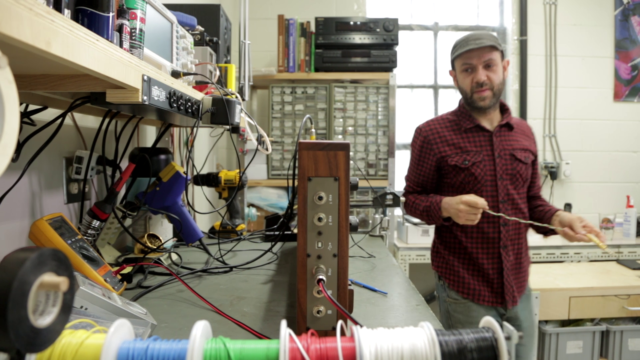
Mark: Ok, tell us your name, company and how long you’ve been working for.
Mike: My name is Mike Beauchamp from Therevox Custom Musical Instruments. Right now my main instrument is the Therevox ET-4 which there is 3 different models with different levels of features. I describe it as a vintage analog Minimoog meets and Ondes Martenot.
What did you change on this instrument compared to the Ondes Martenot?
I wanted to make this instrument so it never breaks down. In addition to the ring, later versions of the Ondes Martenot also had a keyboard but it was pretty fragile so I left that out and stayed true to Maurice Martenot’s earlier versions of the instrument. Most Therevox customers own keyboards and synths that are a lot more powerful than the Ondes Martenot’s single oscillator sound anyways. The beauty of the Ondes Martenot I believe is in the ring (au ruban) and intensity key (touche d’intensité), they are very expressive and unique. The Ondes Martenot used a fishing string on the ring so I re-engineered this to use a steel-core cable that we have custom manufactured so it will never slip, stretch or break. The Ondes Martenot’s intensity key used a leather bag filled with a powder that had a very limited lifespan, so I redesigned this to eliminate that part and use something that will never wear out. I tried to keep the feeling of the instrument the same but use modern materials and engineering.
Creative people want to use tools that were crafted creatively.
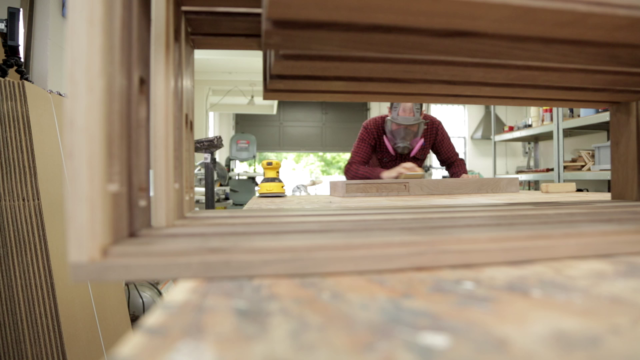
What did you add to the instrument?
Part of the design I did when I was in New Zealand, there’s a bird there called a Tui that has two independent voice boxes. When I was designing this I always wanted it to have two independent voices that you can blend between as a two oscillator synth. I also thought it should have a filter and because your hands connected to the instrument, I brought the filter control out to an expression pedal so you can be controlling that at the same time to. Properly playing a Therevox has your entire body wrapped up; your right hand is controlling pitch, your left hand is controlling the amplitude of two different oscillators and your foot is opening and closing the filter at the same time. It’s very involved, it’s very full-body but you have control of every parameter while you’re playing it. As a synth guy, I also added control voltage (CV) outputs for the ring and intensity keys to hook up to other synths.
What about those big resonator speakers from the Ondes Martenot?
Maurice Martenot was doing a lot of things to create reverberation, hanging large springs in front of big speaker cabinets or hooking speaker motors up to metal gongs and acoustic strings. I wanted to build a reverberation right into the instrument. I’m a big fan of old Fender tube guitar amplifiers and love the spring-reverb units that they use, so I incorporated one of those into all models of the Therevox ET-4.
You obviously put a lot of work into the design and construction of this instrument, can you talk a bit about that?
I’m just trying to make something as well as I can make it. I think people pick up on that. The design was really personal for us and it took a lot of time to get right. When an artist is in their very creative space, it’s a space you have to put yourself into and it’s hard and when you’re there, you’re vulnerable. The tools that you’re given, I think they should have come from a similar space. Do you know what I mean? Creative people want to use tools that were crafted creatively.
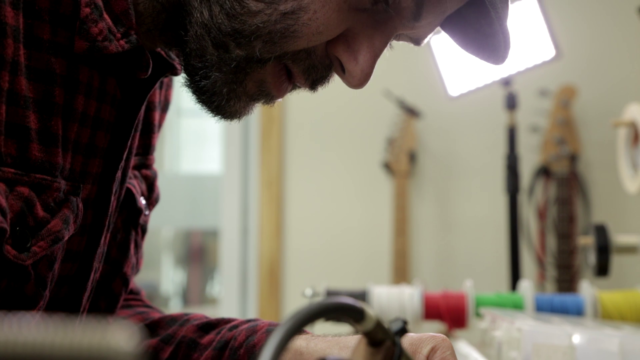
What are some of your favourite artists using the Therevox?
I don’t even know where to start, the instrument has been used on a lot of genres and customers are kindly mailing me CD’s to listen to in the shop. “Images Du Future” by Montreal band Suuns is always a favourite of mine, there’s some great deep Therevox bass slides on that album. Most recently, I’ve been listening to Joan Shelley’s new album that has some Therevox played by Wilco’s Jeff Tweedy.





